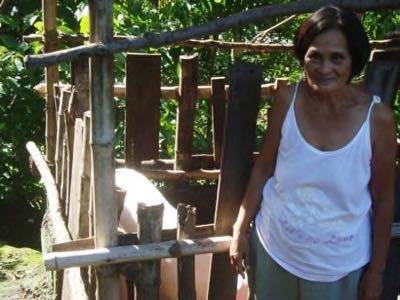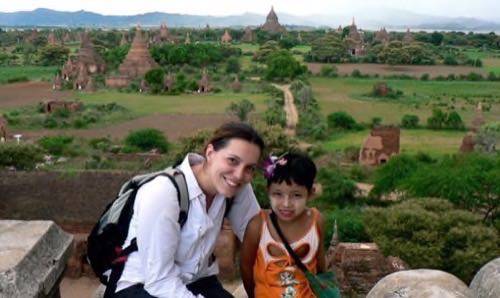It’s been a long and winding road for serial volunteer and social media philanthropist Sloane Berrent.

Since her unplanned departure from an L.A.-based startup in 2008, Berrent has traveled through eight countries, documenting and publicizing the struggles of those in developing areas through her blog posts, tweets, images, videos, and her own presence at events at home and abroad. From post-Katrina New Orleans to a trash dump in Manila to a monastery in Burma, read on for her story of trying to achieve social good through social media.

Editor’s note: This story is part of a series we call Redux, where we’ll re-publish some of our best posts of 2009. As we look back at the year – and ahead to what next year holds – we think these are the stories that deserve a second glance. It’s not just a best-of list, it’s also a collection of posts that examine the fundamental issues that continue to shape the Web. We hope you enjoy reading them again and we look forward to bringing you more Web products and trends analysis in 2010. Happy holidays from Team ReadWriteWeb!
RWW: “Social media for social good” has become the catchphrase du jour, it seems. What does it actually mean; how much can social media users affect social change, and how?
I am a strong believer in the idea that the things you do online are meant to facilitate your offline interactions. People are so fast to click a button, and that can be great. Retweeting, forwarding, and Facebook walls are great engagements. But what’s more difficult is the donate button. That’s the big hurdle and disconnect. I’m trying to provide these inspirational opportunities in time-boxed campaigns. Social media is slowly catching on, but there’s a lot of noise. Standing out is hard; it’s important to have an offline component.
Berrent was visibly disturbed by what she witnessed at this Manila trash dump, where she saw shoeless children running through piles of debris.
RWW: Tell me about your experiences with Kiva borrowers. What kinds of people and enterprises have you seen? In your opinion, does microlending have a measurable impact on struggling local economies?
Kiva is really unique. It has a lot of power users – more than any nonprofit I’ve ever seen. One man has made a thousand loans. It’s individual stories, and people really connect. You get updates on that person, and people say it’s their favorite email of the month. As a microlending company, Kiva is one spoke in the larger wheel of microfinance. On a global scale, it has a very big impact.
Typically, when you go to a village or province, certain industries are prevalent. In a fishing community, maybe the borrower bought a fishnet or a fishing boat. In an area with a lot of bamboo, it’s going to be crafts. I worked in eleven branch offices. I met over 40 different female borrowers individually and over 250 in my time there.
I can see that the money Kiva provides makes a difference. Microfinance is a very slow process, and there are gems and sparks of people who break through the poverty cycle. When you see villages changing, it’s really something. It’s like watching grass grow, but it’s really beautiful grass.
This woman is a pig farmer and a recipient of funds from a Kiva-affiliated organization.

RWW: Now you’re working on a seven-day, seven-city tour to raise awareness and funds for malaria prevention through bed nets. Where did this idea come from?
It’s a city-by-city competition on who can raise the most money for malaria nets, but also an opportunity for anyone to donate who wants to get involved. The tour starts this Saturday night in New York City and continues for the next seven days in Miami, New Orleans, Chicago, Seattle, San Francisco, and ends in Los Angeles on Friday…
I’d just finished Kiva training, and I was going to the Philippines for three months. And all I could think was, “When I come back, I’m going to be thirty.” I’ve honed in a lot on my direction – using the Internet to help people. And what if I could use this opportunity to give back, involving people in different parts of the country – something really ambitious?
I wanted it to be about saving lives. I wanted to say, “I saved this many lives on my birthday.” I’ve done a lot of work in HIV and AIDS; I looked into that and polio and malaria, and that’s what stuck with me. The campaign has no administrative fees. One hundred percent of the funds go to malaria… in rural northern Ghana. Providing malaria nets will really be a part of saving lives there.
Berrent met this monk in Burma and spent the afternoon pagoda-hopping with him.

RWW: What needs or gaps do you see in philanthropic efforts online?
I think it’s not having a strategy to begin with, not knowing the tools in your toolbox before you start. There’s a lot to be said for jumping in and having fun, but nonprofits don’t have the resources to play around online. They think it’s about getting interns and getting followers and fans without figuring out why a medium is important and how to make it successful for them.
RWW: What’s one surprise – good or bad – that you’ve come across since you started working with Kiva? What did you not expect from this experience, and what did you learn?
I learned that it’s much more complicated than the website makes it seem. There’s an entire division devoted to foreign exchange currency. The operational cost analysis, the challenges of technology in the developing world, the processes of remittance – it’s incredibly complex. There are regional specialists. On the site, you can make a loan in five clicks, but a lot of machinery comes together to make it that way.
RWW: What’s next for you? Is there more globe-trotting in your immediate future? How do you think the web will continue to be part of your life and career?
One of the best parts of this past year has been that I’ve gone through long periods where I didn’t have Internet access. That’s brought me a heightened and renewed sense of my purpose in the world and my authentic desire to make the world a better place. I’d like to be able to continue to support campaigns – even for-profit ventures – that I believe in, and I think social business is a wonderful intersection of the two.
I want to explore avenues with online and offline components, while continuing to blog and tell stories I’m passionate about.
Follow Berrent’s next adventures on Twitter or at her blog.

And all this is just the tip of the iceburg that is Sloane Berrent’s fascinating story. For a fuller look at her travels and timeline, check out this list of her nine favorite posts on her blog, The Causemopolitan, covering humanitarianism, her work in New Orleans, the phenomenon of serendipity in international travel, and much more.
Many thanks to Sloane Berrent for the use of her videos and images as well as for sharing her story with us and our readers.










